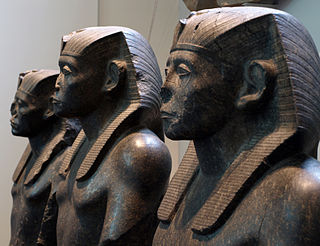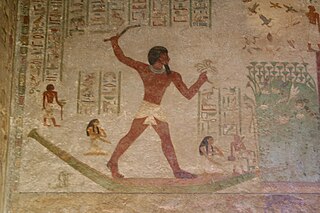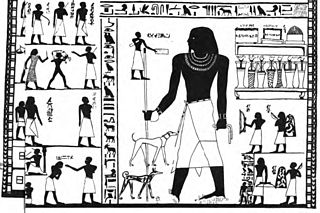Related Research Articles

Amenemhat III, also known as Amenemhet III, was a pharaoh of ancient Egypt and the sixth king of the Twelfth Dynasty of the Middle Kingdom. He was elevated to throne as co-regent by his father Senusret III, with whom he shared the throne as the active king for twenty years. During his reign, Egypt attained its cultural and economic zenith of the Middle Kingdom.

The Middle Kingdom of Egypt is the period in the history of ancient Egypt following a period of political division known as the First Intermediate Period. The Middle Kingdom lasted from approximately 2040 to 1782 BC, stretching from the reunification of Egypt under the reign of Mentuhotep II in the Eleventh Dynasty to the end of the Twelfth Dynasty. The kings of the Eleventh Dynasty ruled from Thebes and the kings of the Twelfth Dynasty ruled from el-Lisht.

Titkheperure or Tyetkheperre Psusennes II [Greek Ψουσέννης] or Hor-Pasebakhaenniut II [Egyptian ḥr-p3-sb3-ḫˁỉ-⟨n⟩-nỉwt], was the last king of the Twenty-first Dynasty of Egypt. His royal name means "Image of the transformations of Re" in Egyptian. Psusennes II is often considered the same person as the High-Priest of Amun known as Psusennes III. The Egyptologist Karl Jansen-Winkeln notes that an important graffito from the Temple of Abydos contains the complete titles of a king Tyetkheperre Setepenre Pasebakhaenniut Meryamun "who is simultaneously called the HPA and supreme military commander." This suggests that Psusennes was both king at Tanis and the High Priest in Thebes at the same time, meaning he did not resign his office as High Priest of Amun during his reign. The few contemporary attestations from his reign include the aforementioned graffito in Seti I's Abydos temple, an ostracon from Umm el-Qa'ab, an affiliation at Karnak and his presumed burial – which consists of a gilded coffin with a royal uraeus and a Mummy, found in an antechamber of Psusennes I's tomb at Tanis. He was a High Priest of Amun at Thebes and the son of Pinedjem II and Istemkheb. His daughter Maatkare B was the Great Royal Wife of Osorkon I.

Nubkaure Amenemhat II, also known as Amenemhet II, was the third pharaoh of the 12th Dynasty of ancient Egypt. Although he ruled for at least 35 years, his reign is rather obscure, as well as his family relationships.

Senusret I also anglicized as Sesostris I and Senwosret I, was the second pharaoh of the Twelfth Dynasty of Egypt. He ruled from 1971 BC to 1926 BC, and was one of the most powerful kings of this Dynasty. He was the son of Amenemhat I. Senusret I was known by his prenomen, Kheperkare, which means "the Ka of Re is created." He expanded Egypt that allowed him to rule over an age of prosperity.

Khakheperre Senusret II was the fourth pharaoh of the Twelfth Dynasty of Egypt. He ruled from 1897 BC to 1878 BC. His pyramid was constructed at El-Lahun. Senusret II took a great deal of interest in the Faiyum oasis region and began work on an extensive irrigation system from Bahr Yussef through to Lake Moeris through the construction of a dike at El-Lahun and the addition of a network of drainage canals. The purpose of his project was to increase the amount of cultivable land in that area. The importance of this project is emphasized by Senusret II's decision to move the royal necropolis from Dahshur to El-Lahun where he built his pyramid. This location would remain the political capital for the 12th and 13th Dynasties of Egypt. The king also established the first known workers' quarter in the nearby town of Senusrethotep (Kahun).

Khakaure Senusret III was a pharaoh of Egypt. He ruled from 1878 BC to 1839 BC during a time of great power and prosperity, and was the fifth king of the Twelfth Dynasty of the Middle Kingdom. He was a great pharaoh of the Twelfth Dynasty and is considered to be, perhaps, the most powerful Egyptian ruler of the dynasty. Consequently, he is regarded as one of the sources for the legend about Sesostris. His military campaigns gave rise to an era of peace and economic prosperity that reduced the power of regional rulers and led to a revival in craftwork, trade, and urban development. Senusret III was among the few Egyptian kings who were deified and honored with a cult during their own lifetime.

Khasekhemre Neferhotep I was an Egyptian pharaoh of the mid Thirteenth Dynasty ruling in the second half of the 18th century BC during a time referred to as the late Middle Kingdom or early Second Intermediate Period, depending on the scholar. One of the best attested rulers of the 13th Dynasty, Neferhotep I reigned for 11 years.

Khnumhotep III was an ancient Egyptian high steward and vizier of the 12th Dynasty.

Senebsumai was an ancient Egyptian official of the early 13th Dynasty with the title high steward and later treasurer.

Senebi was an ancient Egyptian treasurer under the 13th Dynasty kings Neferhotep I and Sobekhotep IV. Senebi belongs to the best attested officials of the 13th Dynasty.

The High Priest of Ptah was sometimes referred to as "the Greatest of the Directors of Craftsmanship". This title refers to Ptah as the patron god of the craftsmen.

Ikhernofret was an ancient Egyptian treasurer of the 12th Dynasty, under king Senusret III until the early years of Amenemhat III. On his monuments he bears several important titles, including overseer of the double treasury, overseer of the double gold house, royal sealer and his main title treasurer. Ihkernofret is known from several stelae found at Abydos. One of these stelae contains a biography. This stela is now in the Egyptian Museum of Berlin. According to its text, Ikhernofret grew up at the royal court. When he was 26, he became friend of the king, which was most likely a special honor. However, the text of the stela is of special importance as it reports the arrangement by Ikhernofret of a festival for Osiris at Abydos.

Usersatet was an Ancient Egyptian official with the titles king's son of Kush and overseer of the southern countries. He was in office under king Amenhotep II and perhaps in the early years of the reign of Thutmosis IV. As king's son of Kush he was the main official in charge of the Nubian provinces.

Khnumhotep II was an ancient Egyptian Great Chief of the Oryx nome during the reign of pharaohs Amenemhat II and Senusret II of the 12th Dynasty, Middle Kingdom. He is well known for his tomb at Beni Hasan and its decorations.

Amenemhat, often reported with his short form Ameny (Jmnjj), was an ancient Egyptian "Overlord of the Oryx nome" and chief priest during the reign of pharaoh Senusret I of the 12th Dynasty.

Sobekemsaf was an ancient Egyptian official of the Thirteenth Dynasty, around 1700 BC. He is especially well known from his statue in Vienna.
The Wadi el-Hudi is a wadi in Southern Egypt, in the Eastern Desert. Here were ancient quarries for amethyst. The Wadi el-Hudi is important in archaeology for its high number of rock inscriptions and stelae, mainly dating to the Middle Kingdom, as amethyst was especially popular in this period. The Wadi el-Hudi ends in the Nile valley a few kilometers north of Aswan and is coming there from the South-East. The ancient amethyst quarries are about 20 kilometres south-east from Aswan.

The Genealogy of Ankhefensekhmet or Genealogy of the Memphite priestly elite is an ancient Egyptian relief – sometimes referred to as a stela – made during the 8th century BCE, under the reign of pharaoh Shoshenq V of the late 22nd Dynasty. A surviving block is kept at the Egyptian Museum of Berlin. The relief was issued by a priest called Ankhefensekhmet with the purpose of illustrating his own genealogy. The relief traces back Ankhefensekhmet's sequence of ancestors up to 60 generations before, with the earliest individuals dating back to the 11th Dynasty.
Ameny was an ancient Egyptian official of the Twelfth Dynasty, most likely in office under king Amenemhat II. Ameny was a great overseer of the troops and is mainly known from a series of stelae (Paris, Louvre C 35, Cairo CG 20546, London, British Museum 162 once set up at Abydos and there adorning a chapel. On these stelae, he bears the most important ranking titles of a member of the elite, foremost of action, royal sealer and sole friend. As a great overseer of the troops, he was the leading official at the royal responsible for organizing manpower that was used in military enterprises, but also for building projects. Ameny was the son of a person called Qebu. On each stelae a different wife is mentioned. These are Itet, Renefankh and Medhu. His tomb was found at Lisht, but is not yet fully excavated. The stelae of Ameny are not dated by any king's name. However, on stylistic grounds, they most likely date under king Senusret I and Amenemhat II. Some of the biographical phrases on the stelae indicate a date more precisely under the latter king.
References
- ↑ James P. Allen: The high officials of the early Middle Kingdom, in: Nigel Strudwick, John H. Taylor (editors): The Theban Necropolis, Past, Present and Future, London 2003, ISBN 0714122475, 17-18